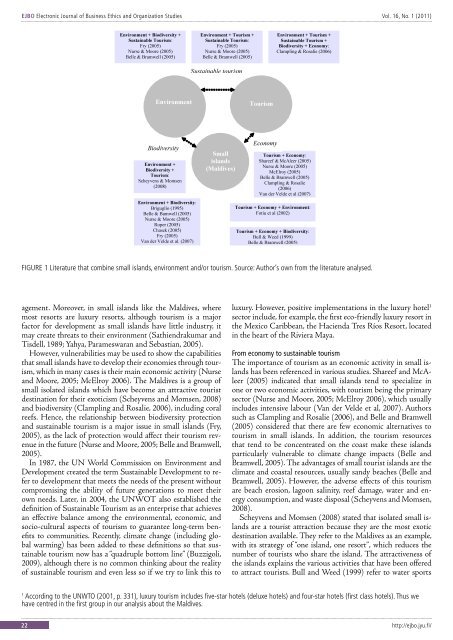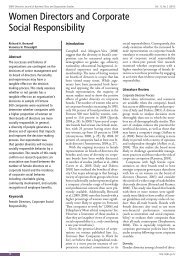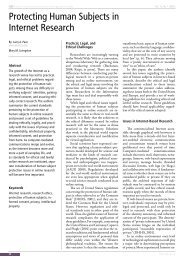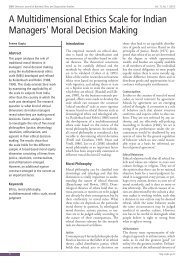View PDF - Electronic Journal of Business Ethics and Organization ...
View PDF - Electronic Journal of Business Ethics and Organization ...
View PDF - Electronic Journal of Business Ethics and Organization ...
- TAGS
- electronic
- ethics
- ejbo.jyu.fi
Create successful ePaper yourself
Turn your PDF publications into a flip-book with our unique Google optimized e-Paper software.
EJBO <strong>Electronic</strong> <strong>Journal</strong> <strong>of</strong> <strong>Business</strong> <strong>Ethics</strong> <strong>and</strong> <strong>Organization</strong> Studies Vol. 16, No. 1 (2011)<br />
FIGURE 1 Literature that combine small isl<strong>and</strong>s, environment <strong>and</strong>/or tourism. Source: Author’s own from the literature analysed.<br />
agement. Moreover, in small isl<strong>and</strong>s like the Maldives, where<br />
most resorts are luxury resorts, although tourism is a major<br />
factor for development as small isl<strong>and</strong>s have little industry, it<br />
may create threats to their environment (Sathiendrakumar <strong>and</strong><br />
Tisdell, 1989; Yahya, Parameswaran <strong>and</strong> Sebastian, 2005).<br />
However, vulnerabilities may be used to show the capabilities<br />
that small isl<strong>and</strong>s have to develop their economies through tourism,<br />
which in many cases is their main economic activity (Nurse<br />
<strong>and</strong> Moore, 2005; McElroy 2006). The Maldives is a group <strong>of</strong><br />
small isolated isl<strong>and</strong>s which have become an attractive tourist<br />
destination for their exoticism (Scheyvens <strong>and</strong> Momsen, 2008)<br />
<strong>and</strong> biodiversity (Clampling <strong>and</strong> Rosalie, 2006), including coral<br />
reefs. Hence, the relationship between biodiversity protection<br />
<strong>and</strong> sustainable tourism is a major issue in small isl<strong>and</strong>s (Fry,<br />
2005), as the lack <strong>of</strong> protection would affect their tourism revenue<br />
in the future (Nurse <strong>and</strong> Moore, 2005; Belle <strong>and</strong> Bramwell,<br />
2005).<br />
In 1987, the UN World Commission on Environment <strong>and</strong><br />
Development created the term Sustainable Development to refer<br />
to development that meets the needs <strong>of</strong> the present without<br />
compromising the ability <strong>of</strong> future generations to meet their<br />
own needs. Later, in 2004, the UNWOT also established the<br />
definition <strong>of</strong> Sustainable Tourism as an enterprise that achieves<br />
an effective balance among the environmental, economic, <strong>and</strong><br />
socio-cultural aspects <strong>of</strong> tourism to guarantee long-term benefits<br />
to communities. Recently, climate change (including global<br />
warming) has been added to these definitions so that sustainable<br />
tourism now has a “quadruple bottom line” (Buzzigoli,<br />
2009), although there is no common thinking about the reality<br />
<strong>of</strong> sustainable tourism <strong>and</strong> even less so if we try to link this to<br />
luxury. However, positive implementations in the luxury hotel 1<br />
sector include, for example, the first eco-friendly luxury resort in<br />
the Mexico Caribbean, the Hacienda Tres Ríos Resort, located<br />
in the heart <strong>of</strong> the Riviera Maya.<br />
From economy to sustainable tourism<br />
The importance <strong>of</strong> tourism as an economic activity in small isl<strong>and</strong>s<br />
has been referenced in various studies. Shareef <strong>and</strong> McAleer<br />
(2005) indicated that small isl<strong>and</strong>s tend to specialize in<br />
one or two economic activities, with tourism being the primary<br />
sector (Nurse <strong>and</strong> Moore, 2005; McElroy 2006), which usually<br />
includes intensive labour (Van der Velde et al, 2007). Authors<br />
such as Clampling <strong>and</strong> Rosalie (2006), <strong>and</strong> Belle <strong>and</strong> Bramwell<br />
(2005) considered that there are few economic alternatives to<br />
tourism in small isl<strong>and</strong>s. In addition, the tourism resources<br />
that tend to be concentrated on the coast make these isl<strong>and</strong>s<br />
particularly vulnerable to climate change impacts (Belle <strong>and</strong><br />
Bramwell, 2005). The advantages <strong>of</strong> small tourist isl<strong>and</strong>s are the<br />
climate <strong>and</strong> coastal resources, usually s<strong>and</strong>y beaches (Belle <strong>and</strong><br />
Bramwell, 2005). However, the adverse effects <strong>of</strong> this tourism<br />
are beach erosion, lagoon salinity, reef damage, water <strong>and</strong> energy<br />
consumption, <strong>and</strong> waste disposal (Scheyvens <strong>and</strong> Momsen,<br />
2008).<br />
Scheyvens <strong>and</strong> Momsen (2008) stated that isolated small isl<strong>and</strong>s<br />
are a tourist attraction because they are the most exotic<br />
destination available. They refer to the Maldives as an example,<br />
with its strategy <strong>of</strong> “one isl<strong>and</strong>, one resort”, which reduces the<br />
number <strong>of</strong> tourists who share the isl<strong>and</strong>. The attractiveness <strong>of</strong><br />
the isl<strong>and</strong>s explains the various activities that have been <strong>of</strong>fered<br />
to attract tourists. Bull <strong>and</strong> Weed (1999) refer to water sports<br />
1 According to the UNWTO (2001, p. 331), luxury tourism includes five-star hotels (deluxe hotels) <strong>and</strong> four-star hotels (first class hotels). Thus we<br />
have centred in the first group in our analysis about the Maldives.<br />
22 http://ejbo.jyu.fi/











